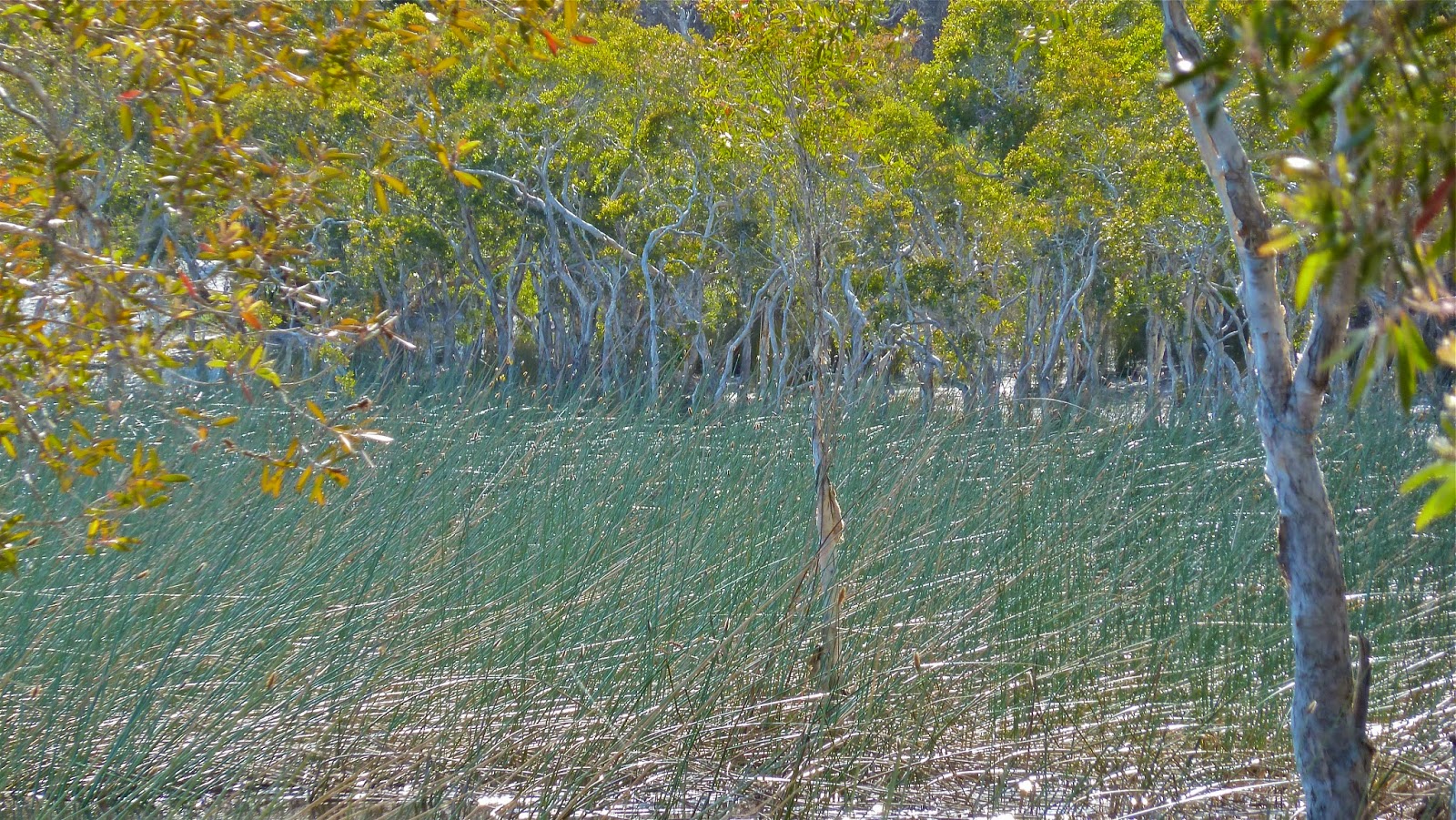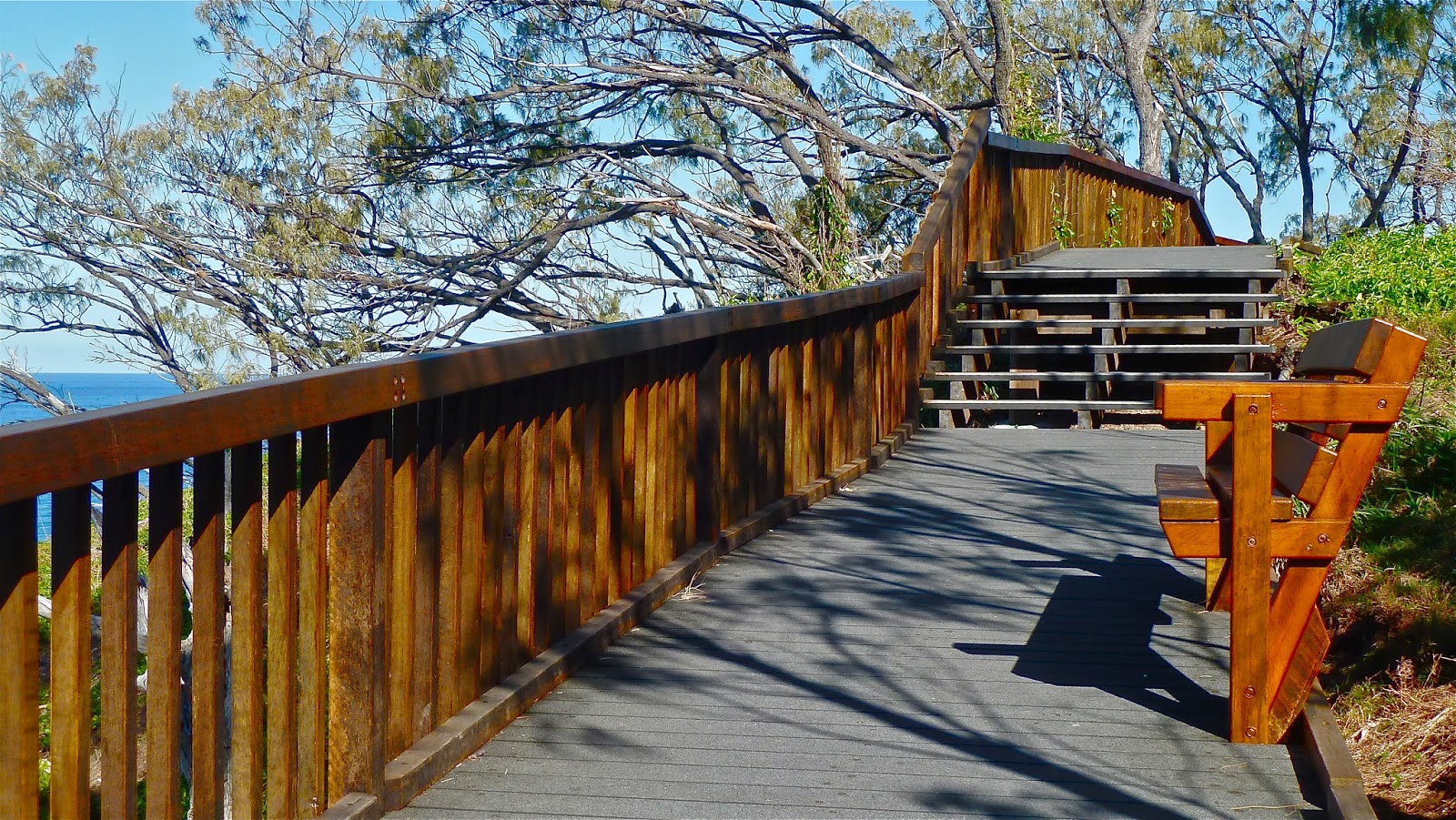Last October I returned to North Stradbroke Island (Minjerribah); this time in the comfort of a car, and for longer than a few hours (see A day on Straddie, January 2011). It is a beautiful island that feels much further than 30 kilometres away from Brisbane's CBD. Its beaches, lakes and wildlife are stunning.
The trip didn't start well. We hit a serious traffic jam 15 minutes from home, on the Gateway Motorway: and we were only travelling from one junction to the next. Then came a text from Stradbroke Ferries warning of a 25-minute delay to our 6-pm crossing from Cleveland to Dunwich, which was just as well. It was worse than predicted, however, and dark by the time we were loaded. But a journey by train, boat or plane adds to the sense of adventure, no matter what.
Once on the Island, roughly a 50-minutes sail away, we were in a convoy across to Point Lookout, where most people were headed. At 8.30, it was late to be checking in at Samarinda. We dumped our bags and left, lucky to find a cafe still serving supper.
Next morning there was a feeling of having a lot to see and needing to get on. For the first time, we realised how close we were to Main Beach, right at the eastern end of Point Lookout. Samarinda apartments had been recommended by friends, who were not wrong about the ability to whale-watch from the comfort of your bed. Our apartment was spacious and pleasantly decorated, but we had noisy neighbours. It was school hols, so did we expect peace and solitude? We live in hope.
After breakfast at one of the cafes in the parade of shops on East Coast Road, we took our bearings from Captain Cook Lookout and surveyed another lovely beach – Frenchman's.
We needed a permit to drive on Main Beach. I'd checked that it didn't need to be purchased in advance, but I couldn't have predicted how difficult buying one on the Island might be. The tourist information office had long since left Shop 1, Kennedy Drive in Point Lookout, but I was told I could pick up a permit at the camping kiosk in the Cylinder Beach car park. Cylinder is a sheltered beach and popular with families. I don't think I've ever seen such a crowded beach anywhere in Australia, even on the Gold Coast.

The first problem was that I could only buy a permit for a year: we were on the Island for three days. It cost the best part of $50 but the woman in the kiosk didn't take cards. Neither did she have change for a $50 note. I'd stood at the counter a while before she acknowledged my existence; she didn't care a jot whether I got a pass or not; and even writing my name and the date on the permit – once she'd gathered change from somewhere – seemed to be a challenge. Make sure you get one online before you visit.
We headed west from town and turned off the East Coast Road on to Beehive Road and Claytons Road to Amity, on the Island's northwest tip. It's a sleepy little place, and there is beach access (for 4WDs) 2.5 kilometres beyond the settlement. (And yes, we were on North Stradbroke, not Moreton Island.)
 |
| Waters meet off the point |
On returning from a quick look at Flinders Beach on the way back from Amity to the East Coast Road, we stopped for me to photograph some interesting black stalks. My friend heard a bird call on the other side of the road and wound down his window to take a look. That's when he spotted the wildlife wonder of the weekend.
The Island's koalas are unique. They are genetically different – with their blotchy rump – and, having been isolated on Straddie for thousands of years, have managed to avoid the diseases ravaging mainland koalas. Habitat destruction has not had as much of an impact here either. These are one of only two endemic island populations of koalas in Australia, the other being on Rabbit Island, north of Mackay (QLD).
We tried to minimise our presence, pointing at the black stalks whenever any cars went past, so they wouldn't stop to see what we were really looking at. The koala watched us but didn't seem bothered: we didn't linger too long. I hadn't seen a koala in the wild for a couple of years. It was my birthday and there could have been no better present.
 |
| Shy |
 |
| Time for a siesta? |
We headed back to Dunwich for a quick bite of lunch. While we were eating our sandwiches by the Oval, we spotted two Beach Stone-curlews keeping a low profile. Well, I thought they were the Beach variety: my friend favoured the Bush.
Straddie has two noteable Lakes: the Brown and the Blue. (It has lots but you can't access most of them because they're within mining lease boundaries.) The Brown Lake (Bumiera) Recreation Reserve is only 3.5 kilometres east of Dunwich, along Tazi Road. We wanted to walk around it: there was a track clearly marked on our Hema map; and it was mentioned in the Department of National Parks' Naree Budjong Djara pamphlet. No one else was walking: they all stayed close to their cars. We pressed on up the western side, along the top, and down the eastern side. There were lots of beautiful natural wonders. In case you're wondering how an island made of sand can support lakes: they are 'perched' on soft rock formed by the compaction of organic material.
It's tea tree that makes water brown, but the Lake looked predominantly blue to me.
We reached a point where the path should have veered to the right round the bottom of the Lake, but it carried straight on and led eventually to the golf course southeast of Brown Lake. We retraced our steps but the only, rather indistinct pathway heading in the right direction led between some hives where there were many bees a-buzzing. If we could have found our way through the golf course to the main road, it would have been a long way back to the car. So we walked anticlockwise back around the Lake the way we had come.
A few kilometres further down Tazi Road is Blue Lake National Park (Karboora), which was on the next day's agenda, but only after we'd driven down Main Beach. Sunday was even hotter than Saturday and gloriously sunny. We accessed the beach just south of Point Lookout, via George Nothling Drive. I don't believe I would ever tire of driving on beaches like this: it is an enormous privilege to be able to do so.
 |
| Pied Oystercatcher |
At one point we parked up and ventured through the casuarinas at the back of the beach, where a few people were camping illegally, thinking they couldn't be seen. We were searching for bird life, or a lagoon, I can't quite recall, but it was hot away from the ocean. Back on the beach, my friend went for a swim while I litter-picked. I was horrified how much plastic I collected in 20 minutes.
We drove on south until waves cut us off from what lay beyond. The cars must have been at Jumpinpin, the southern tip of the Island. The Gold Coast loomed ghostly behind them.
We turned north and prepared to leave the beach at the access from Tazi Road. There was a line because people were getting bogged in the deep sand; others were jumping the queue. My friend decided to take it at speed: unfortunately, he forgot to close the windows. We're still finding Straddie sand in the car, five months later.
The country beyond 'the causeway' was swampy.
Blue Lake National Park wasn't far away. It's a five-kilometre-return walk from the roadside car park, and you pass Tortoise Lagoon on the way, but there was little water to be seen in the latter when we visited. The picturesque wallum woodland includes eucalypts, banksias, sedges and my beloved dancing grass trees.
 |
| Noisy Friarbird |
The Lake was definitely blue.
The colours of the grasses were equally impressive. And the woodland light and shade.
 |
| Purple Swamphen |
We had been hoping to avoid returning home via Dunwich by cutting across country on the Tripod Track, but access from Tazi Road had been, let's say, 'disguised'. Hema warns against 'conditions on this map… constantly changing'. They were not wrong. Part of the Track happens to run through the Yarraman Mining Lease area, which I suspect was not an irrelevance.
Straddie's only access roads are in the most northerly third of the Island: the rest of it is mining leased or mines in operation. Belgian company Selbelco's rights to mine sand were controversially extended by the Newman government – following large donations to the LNP during the 2012 state election campaign.
That night we ate at the pub, Stradbroke Island Beach Hotel. The NRL grand final between the South Sydney Rabbitohs and the Canterbury Bulldogs had just kicked off and the place was heaving. We queued for half an hour to order food, chatting to a chap who'd already got into the spirit of the occasion. We shared a love of Byron and compared notes on Melbourne's eateries and watering holes. Suddenly I was a Rabbitohs fan. They hadn't won a title for more than 40 years, but they did that night.
Our third and final day began with an hour's run along the glorious Main Beach, which had the added bonus of a Fur Seal recuperating on the rocks. A surf lifesaver explained that the seal had arrived injured a couple of months before. (He did have a head but was reluctant to turn it my way.)
We had earned a hearty breakfast at Tiller's Cafe Pantry by the Allure Stradbroke Resort on the way out of Point Lookout.
We made another attempt to get on to the Tripod Track, this time from its other end, by the junction of the roads to Amity and Point Lookout. It took a few minutes to locate, and was not an easy track, having deep sand-filled ruts up a steep climb. It was worth the effort, however, for the view from Tripod Lookout all over Straddie and across Moreton Bay to the mainland. We even spotted Mt Warning. And had the place all to ourselves. It was hot and the fine sand was brilliant white.








There was one more must-do on my list: the Gorge walk at Point Lookout. There is a North Gorge and a South Gorge: it doesn't matter which end you start from, the views are stunning, and you're almost bound to witness sea life in one form or another. We saw a pod of dolphins fishing: some of them were circling and churning up the water while their mates reaped fishy rewards in the centre of the melée. There are lots of benches along the path from which to sit and stare. It takes about 30 minutes unless you're the sort that stops a lot. There's a blowhole, which gives Whale Rock its name. The walk is best described in pictures.
We caught a ferry back to the mainland at 5. More dolphins played in the harbour shallows in the late afternoon sun, which had set by the time we docked in Cleveland.



















































































